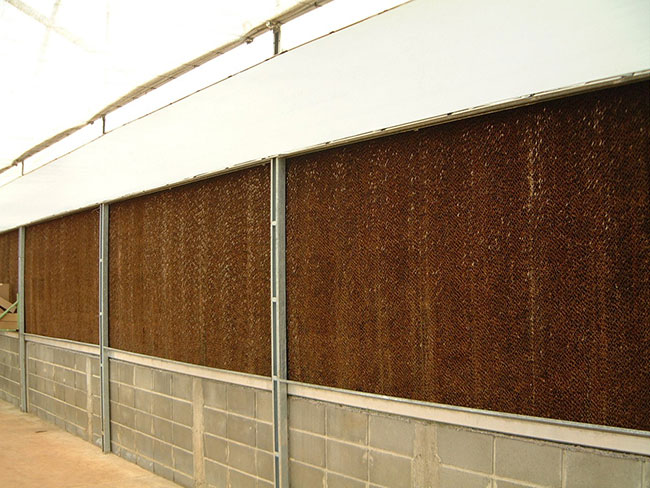Methods of Evaporative Cooling for Achieving Climate Control: Technically Speaking
One of the major reasons we grow crops in greenhouses is for temperature control. While it is relatively easy (but not necessarily cheap) to heat greenhouses, it can be challenging to cool them. Air conditioning is almost always too expensive. Shading compounds and screens that decrease solar light transmission can suppress the temperature rise in a greenhouse, but the air temperature is still at least as high as that outside. The only practical way to decrease the greenhouse air temperature is evaporative cooling using a fan-and-pad or fog system.

High temperature can decrease crop quality and delay flowering. What constitutes a high temperature depends on the crop, but quality can begin to deteriorate for some cold-tolerant species (i.e., pansy and nemesia) at temperatures above 73° F (23° C). A high temperature for other crops, particularly those native to subtropical and tropical regions, may not occur until around 86° F (30° C). Similarly, temperatures that delay flowering can range from 72° F (22° C) for some floriculture crops to 79° F (26° C) for others. Temperature delays in flowering are often caused by a high night (not day) temperature.
Greenhouse cooling systems use the process of evaporation, which requires energy to convert water from a liquid into a gas phase. As warm air heats water, energy is consumed and the air gets cooler. The rate of evaporation depends on several factors, including temperature and humidity (or vapor-pressure deficit), wind speed, and surface area. Therefore, the efficacy of evaporative cooling for greenhouses depends on these factors, which are influenced by environmental conditions outdoors and the design and maintenance of the cooling system.
Fan-and-pad systems

This type of evaporative cooling system involves the use of exhaust fans at one end of the greenhouse that draw outside air through a pad layer of trickling water (Figure 1) from the other end of the greenhouse. A well-designed and well-maintained system can significantly decrease the air temperature brought inside a greenhouse, especially in arid regions and when the dewpoint is relatively low. In such systems, the inlet air temperature is typically just above the dewpoint, which varies by location and time of year.
Briefly, guidelines for an effective fan-and-pad system design include:
- Exhaust fan capacity of at least 8 cubic feet per minute (cfm) per square foot (ft2) of greenhouse floor. This may need to be adjusted based on the distance between the pads and fans and greenhouse elevation.
- A minimum pad area (ft2) that is calculated by dividing the cfm for fan capacity by 250 for a 4-inch (10-cm) cellular pad and 350 for a 6-inch (15-cm) pad.
- Water pumped from tanks is evenly distributed along the top of the pads at a rate of around 0.4 or 0.6 gallons per minute per ft2 of 4-inch or 6-inch pad, respectively.
- Water collected by gutters below the pads is filtered and piped to water tanks, with little lost during the process.
Fan-and-pad systems are less effective when some exhaust fans are not operational, water doesn’t trickle down parts of the pad, or pads are not maintained and periodically replaced. In addition, other vents need to be closed so that all the air that enters the greenhouse is through the wet pads. Visit www.bit.ly/Fan-and-pad for more detailed information from the University of Florida.
Fog Systems
Fog (or fine-mist) systems can be more effective and need less maintenance than fan-and-pad systems but are usually more expensive. A typical fog system has a high-pressure pump and nozzles that create very fine water droplets of less than 50 microns in diameter. For greenhouses without exhaust fans, nozzles should be distributed near the top of a greenhouse so that the water droplets evaporate before reaching the crop below. Another kind of fog system consists of water injected at the edge of a high-speed fan, which creates a stream of fine mist and fog. These units are also placed near the top of the greenhouse. Regardless of fog system, it should be controlled by an environmental control computer and operate based on temperature and the water vapor-pressure deficit.
Anecdotally, the biggest challenge with fog systems is the clogging of nozzles. This can be mitigated by using nozzles with fine-particle (e.g., 5 micron) filters and water with very low dissolved solids, such as reverse osmosis or rainwater. Over time, even water with low concentrations of minerals (calcium, iron, etc.) accumulates in the system, necessitating more frequent maintenance. Nozzles should also have check valves so that they don’t drip when the system turns off.


 Video Library
Video Library 




















